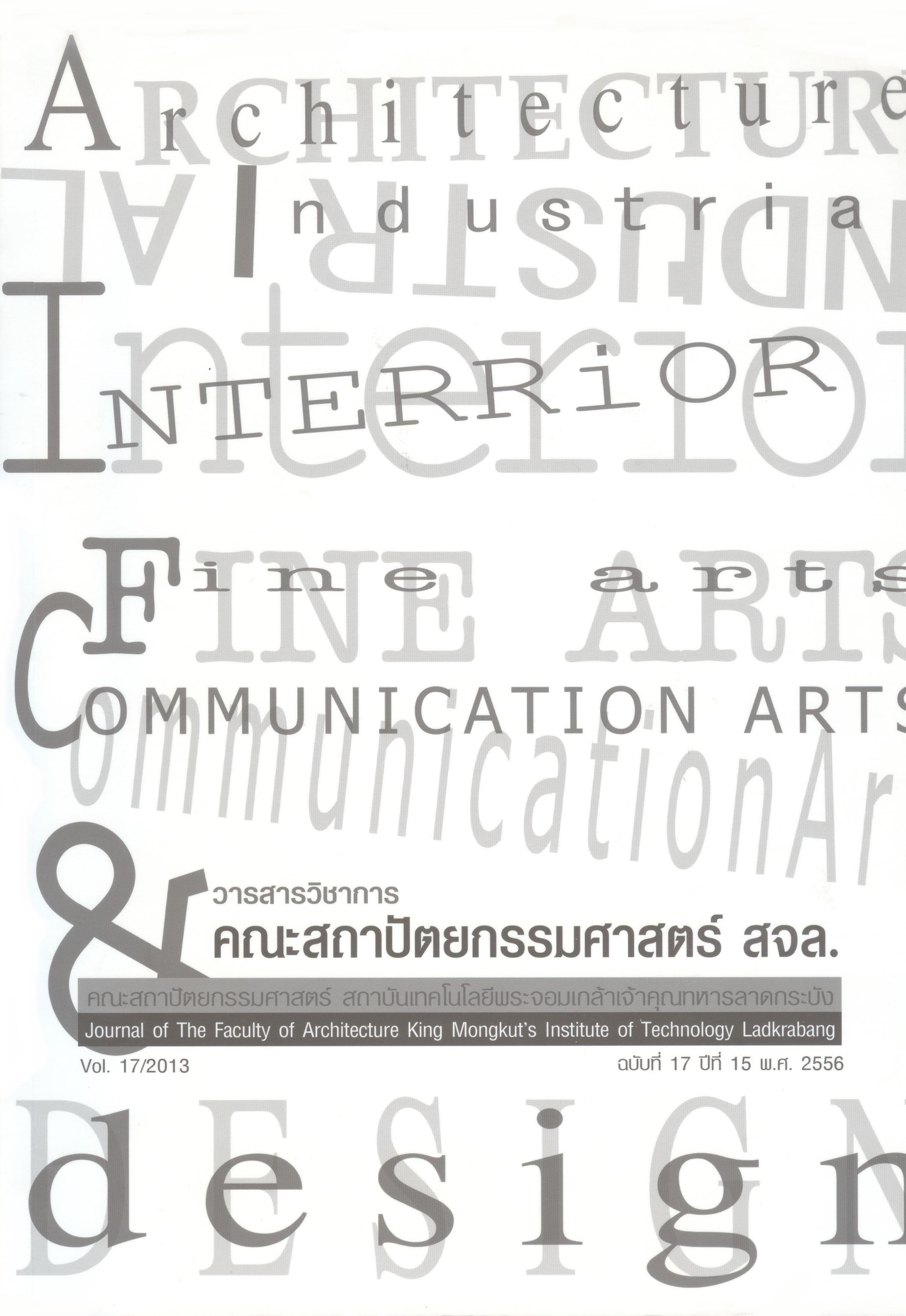สถาปัตยกรรมกระดาษพับ (Origami Architecture)
Main Article Content
Abstract
บทคัดย่อ
การเรียนการสอนในสตูดิโอออกแบบสถาปัตยกรรมนั้น เป็นกระบวนการในเรียนรู้วิธีการออกแบบที่มีความหลากหลายและประกอบด้วยประเด็นในการศึกษามากมาย เช่นการจัดวางพื้นที่ใช้สอย การจัดการงานก่อสร้าง การออกแบบงานระบบประกอบอาคารต่างๆ รวมถึง เรื่องของแนวความคิดในการออกแบบสถาปัตยกรรม เป็นต้น กระบวนการที่จะทำให้นักศึกษาได้เรียนรู้ ได้ทดลองสร้างสรรค์งานสถาปัตยกรรมนั้น จะเป็นการออกแบบผ่านโจทย์ หัวข้อการออกแบบโครงการประเภทต่าง เช่น บ้านพักอาศัย อาคารสำนักงาน การออกแบบโรงเรียน โรงแรม โรงพยาบาล ตลอดจนงานที่เป็นอาคารสูง และโครงการขนาดใหญ่ ฯลฯ ความยากง่ายเป็นไปตามลำดับชั้นปี ในระหว่างการให้โจทย์หลักนี้จะมีโจทย์ย่อยๆ ที่เป็นลักษณะของ Sketch Design แทรกอยู่ เพื่อฝึกฝนกระบวนการเรียนรู้ ซึ่งหนึ่งใน Sketch Design ที่ใช้สอนในสตูดิโอ วิชาออกแบบสถาปัตยกรรม 5 คือโครงการสถาปัตยกรรมกระดาษพับ (Origami Architecture) ที่ใช้เป็นโจทย์ของกระบวนการสอนต่อเนื่องมาเป็นเวลาหลายปี หลักการของการทำงานชิ้นนี้คือนำกระดาษขนาด A4 แนวตั้ง (portrait) มาพับครึ่งและให้แนวพับนั้นเกิดรูปสามมิติของตัวงานสถาปัตยกรรมที่เลือกมาทำ วัตถุประสงค์ของการเรียนรู้มีอยู่สามประเด็นหลักคือ 1) ให้เห็นกระบวนการก่อสร้างงานโดยคำนึงถึงวัสดุสำหรับงานสถาปัตยกรรม 2) ให้รู้จักการมองรูปแบบสองมิติมาเป็นงานสามมิติและสามารถลดทอนรายละเอียดทางสถาปัตยกรรมได้ และ 3) ให้มีการวางแผนการทำงานเป็นลำดับรวมถึงฝึกฝีมือในการตัดกระดาษให้เกิดความประณีต ในการทำงานผลการเรียนรู้จากการทำงานที่เกิดขึ้น ได้มีการประเมินผลงานโดยนักศึกษา จากการทำงานเพื่อปรับปรุงกระบวนการคิด ผลลัพธ์ของงานสถาปัตยกรรมกระดาษพับ Origami Architecture นี้ได้เป็นชิ้นงานที่สามารถนำไปจัดแสดงได้ แต่บางชิ้นก็ได้เป็นเพียงเศษกระดาษที่ส่งลงถังขยะเท่านั้น โดยภาพรวม นักศึกษามีความเข้าใจถึงวัตถุประสงค์ของงาน ได้เรียนรู้ทักษะในการทำงานและสนุกกับการทำสถาปัตยกรรมกระดาษพับนี้ บางคนสามารถนำไปต่อยอดในกระบวนการคิดงานสถาปัตยกรรมในอนาคตรวมถึงการทำงานสถาปัตยกรรมกระดาษ (Origami Architecture) เป็นงานอดิเรกได้
คำสำคัญ: สถาปัตยกรรมกระดาษพับ กระบวนการออกแบบ การเปรียบเทียบ
กระบวนการเรียนรู้ การทำงานในสตูดิโอ
Abstract
In architecture school, the studio setting is the main education tools for students in order to learn the essence of creative and design process. Architecture Studio work offers many area of knowledge, for example the functional layout, the construction process, the building equipment, and concept in architecture design. Student will learn the design process through a series of program or project design, such as, housing, office building, school, hotel, hospital etc. The difficulty of each project ranges from easy to the difficult, as the student move up thought the higher year. In between the main architectural design projects, there is a smaller project called ‘Sketch Design’. Its offer some area of design issue, for example, one of the sketch design in Architectural Studio 5 is the ‘Origami Architecture’. The work done in studio is cut and folded up a piece of paper A4 portrait, to create a form of 3-dimensional paper architecture. The objective of this project focus on three areas of study: 1) to see the construction process which limits to a piece of paper as a construction material, 2) be able to simplify architectural form and 3) be able to plan to finish the work within the time limit.The evaluation of this project is done by students, given the comment back via Facebook. This feedback can be used as a recommendation for the revision of the project. The result of Origami Architecture, some piece can be put on the exhibition, but some could only be in a trash can. However, all of the students learn something related to the project’s objective. They learn to enjoy the work in studio and can adapt the knowledge for the future design process.
Keyword: Origami Architecture Design Process
Comparison Learning Process Studio work
Article Details
This work is licensed under a Creative Commons Attribution-NonCommercial-ShareAlike 4.0 International License.
Copyright Transfer Statement
The copyright of this article is transferred to Journal of The Faculty of Architecture King Mongkut's Institute of Technology Ladkrabang with effect if and when the article is accepted for publication. The copyright transfer covers the exclusive right to reproduce and distribute the article, including reprints, translations, photographic reproductions, electronic form (offline, online) or any other reproductions of similar nature.
The author warrants that this contribution is original and that he/she has full power to make this grant. The author signs for and accepts responsibility for releasing this material on behalf of any and all co-authors.


